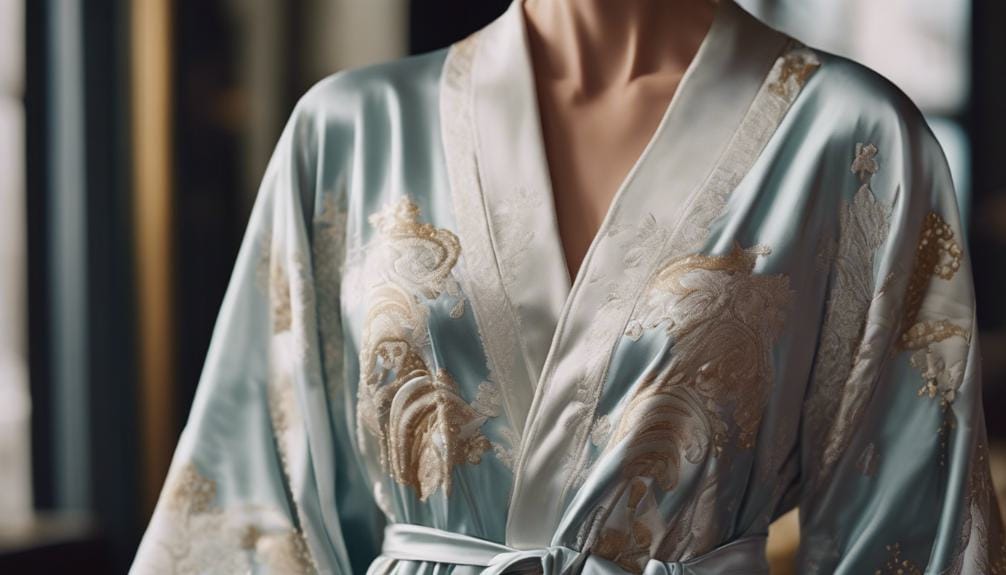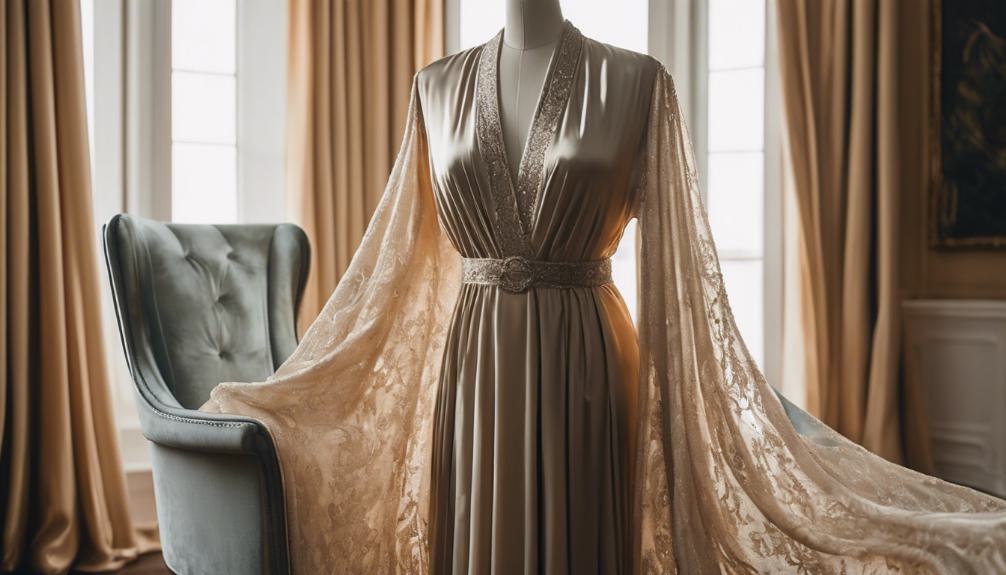Robe vs Gown: Choosing Comfort or Elegance
When it comes to deciding between a robe and a gown, it’s important to take into account the subtle nuances that differentiate the two garments. The robe, with its origins rooted in practicality and everyday use, offers a sense of ease and functionality that is hard to match.
On the other hand, the gown exudes an air of sophistication and elegance, often reserved for special occasions where making a statement is paramount. As you ponder the choice between comfort and style, explore further into the fabric, material, and overall practicality that each option brings to the table, guiding you toward selecting the perfect garment for your needs.
Key Takeaways
- Robes prioritize comfort and practicality with absorbent materials and convenient features for everyday wear.
- Gowns focus on elegance and sophistication, tailored from luxurious fabrics for formal events.
- Fabric choice distinguishes robes (cotton, terry cloth) for comfort and gowns (silk, satin) for luxury.
- Personal preference and occasion dictate the choice between a robe for daily comfort and a gown for formal elegance.
Key Differences Between Robes and Gowns
When comparing robes and gowns, the key differences become apparent in their intended use and design features.
Robes, often referred to as dressing gowns, are primarily designed for comfort and practicality. They serve the purpose of providing a cozy garment to wear when getting dressed or unwinding at home. Made from materials like cotton or terry cloth, dressing gowns are known for their absorbent qualities, making them ideal for post-shower routines or lounging around the house.
On the other hand, gowns are associated with formal events and ceremonies, embodying elegance and sophistication. Unlike robes, gowns are tailored from luxurious fabrics, such as silk or satin, to exude a sense of glamour and style. When you slip into a gown, it’s not just about getting dressed; it’s about making a statement and feeling special for the occasion at hand.
While robes may feature practical elements like hoods, pockets, or belts for convenience, gowns are crafted with intricate designs and embellishments like lace or embroidery to enhance their aesthetic appeal.
The distinction between dressing gowns and gowns lies in their intended purpose, with robes focusing on comfort and functionality for everyday wear, while gowns emphasize style and formality for special events.
Comfort and Style Comparison
Comparing the comfort and style aspects of robes and gowns reveals distinct differences in their intended purposes and design aesthetics. Robes, often referred to as dressing gowns, are primarily designed to keep you warm and cozy, especially after a bath or during lounging hours. They prioritize functionality and comfort, typically made from absorbent materials like cotton or terry cloth to aid in quick drying and warmth retention. Robes are meant for daily wear, emphasizing ease of movement and practicality.
On the other hand, gowns are associated with elegance and formal occasions, focusing more on style and sophistication rather than practicality. Gowns are tailored for special events, showcasing intricate details and luxurious fabrics like silk or velvet. They’re traditionally worn by women, featuring elaborate designs that exude a sense of glamour and grace.
While robes aim to provide a sense of relaxation and warmth, gowns are intended to make a fashion statement and create a lasting impression. Understanding the distinct purposes of these garments can help you choose the appropriate attire for different occasions, whether you seek comfort and functionality or style and elegance.
Fabric and Material Variations

Robes and gowns differentiate themselves not only in their intended purposes but also in the meticulous selection of fabrics and materials utilized to enhance their distinct characteristics and functionalities. When it comes to dressing and fabric variations, the choice of material plays an important role in defining the garment’s overall appeal and functionality:
- Robes: Commonly made from materials like cotton, terry cloth, or silk, robes prioritize comfort and absorbency. Cotton and terry cloth varieties are favored for their softness and ability to wick away moisture, making them ideal for everyday use.
- Gowns: In contrast, gowns often feature luxurious fabrics such as satin, velvet, or chiffon, tailored for formal events where elegance is paramount. These opulent materials elevate the gown’s appearance, adding a touch of sophistication to special occasions.
- Cotton and Terry Cloth Robes: Known for their comfort and practicality, cotton and terry cloth robes are popular choices for their cozy feel and moisture-wicking properties, perfect for lounging at home or post-shower relaxation.
- Silk Robes: Silk robes exude luxury with their smooth texture and elegant drape, offering a sophisticated touch to your dressing routine. Ideal for indulging in a bit of opulence, silk robes are a symbol of refined comfort and style.
Practicality and Functionality Features
For best functionality and practicality, gowns are meticulously crafted to embody elegance and sophistication, featuring intricate designs and flowing silhouettes that elevate them above the utilitarian nature of robes. Gowns prioritize dressing for formal events, delivering a sense of luxury and style. While robes excel in their absorbent materials like cotton or terry cloth, ideal for post-bath wear, gowns offer a different kind of functionality.
Robes typically come equipped with features like hoods, pockets, and belts, enhancing their practicality for everyday use. The addition of these elements provides convenience and comfort for tasks around the house or simply lounging. On the other hand, gowns may lack these specific practical features but compensate with intricate embellishments and designs that make them stand out in formal settings.
When choosing between a robe and a gown, consider the purpose you intend to wear them for. If you seek comfort and functionality after a shower, a robe with absorbent materials and added features like pockets might be the better choice. However, if you’re attending a formal event and wish to make a statement with your attire, a gown with its elegant design and flowing silhouette would be more suitable. The decision ultimately lies in how you prioritize dressing for the occasion.
Choosing the Right Garment for You

When selecting between a robe and a gown, your choice hinges greatly on the occasion you’re dressing for and the level of elegance and functionality you desire in your garment. To guarantee the best user experience, consider the following factors:
- Occasion: Robes are ideal for casual wear around the house, offering comfort and functionality. Gowns, on the other hand, are better suited for formal events where a touch of elegance is required.
- Design: Gowns tend to be more elaborate and sophisticated in design, featuring intricate details and luxurious fabrics. Robes, in contrast, are simpler and more straightforward in their appearance.
- Material: Robes are typically made from cozy fabrics like cotton or terry cloth, providing a comfortable and breathable option for everyday use. Gowns often use high-end materials such as silk or satin, adding a luxurious feel to special occasions.
- Fit: Robes are generally loose-fitting to allow for ease of movement and a relaxed fit, perfect for lounging around the house. Gowns may have a more tailored and form-fitting silhouette, enhancing your figure for formal events.
Frequently Asked Questions
What Is the Difference Between a Robe and a Dressing Gown?
When choosing between a robe and a dressing gown, consider the intended use and fabric. Robes prioritize functionality and absorbency, ideal for post-bath warmth, while dressing gowns offer a luxurious feel for leisure activities with materials like silk or velvet.
Is a Robe a Gown?
A robe is not a gown. Robes are worn for relaxation or post-bathing, while gowns are formal attire for special occasions. Understanding their differences is key to choosing the right outfit for the appropriate event.
What Is the Difference Between a Dress and a Gown?
When considering the difference between a dress and a gown, remember that dresses are versatile for various occasions, while gowns are typically more formal and elaborate, suited for special events. The key lies in formality, design complexity, and occasion appropriateness.
What Is the Difference Between a Bathrobe and a Bath Gown?
For your comfort and style needs at home, the bathrobe is perfect for post-bath drying with its absorbent materials. On the other hand, a bath gown offers a lighter, versatile option, providing warmth without heavy absorption.
Conclusion
To conclude, when deciding between a robe and a gown, it’s crucial to take into account your specific needs and preferences.
Robes offer practicality, comfort, and functionality, perfect for everyday use like drying off after a bath.
On the other hand, gowns are elegant, sophisticated, and ideal for special occasions where you want to make a statement.
Choose the garment that best suits your style, purpose, and comfort level to make sure you feel confident and comfortable in your choice.
